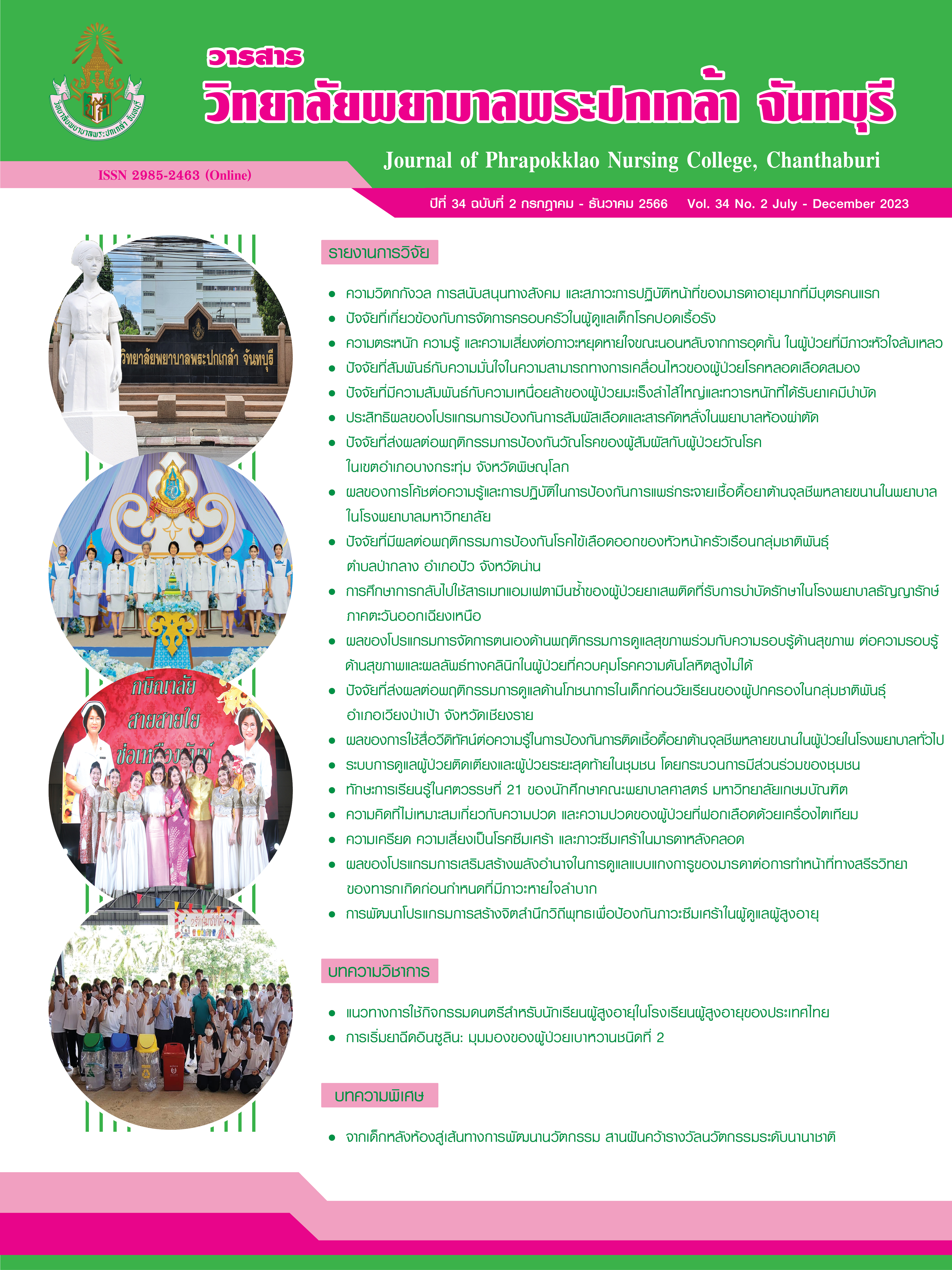Effect of the Maternal Kangaroo Care Empowerment Program on Physiological Functions of Preterm Infants with Respiratory Distress Syndrome
Keywords:
Empowerment program, Preterm infants, Kangaroo care, Physiological functions, Respiratory distress syndromeAbstract
This quasi-experimental research aimed to study the effect of the maternal kangaroo care empowerment program on physiological functions of preterm infants with respiratory distress syndrome. The samples consisted of 30 pairs of mothers and preterm infants with respiratory distress syndrome undergoing treatment in the neonatal intensive care unit of Nakornping Hospital, Chiang Mai Province and were equally divided into an experimental group (n = 15) and a control group (n = 15). The research instruments included the maternal kangaroo care empowerment program, the picture of preterm infant, the video of infant kangaroo care, the pamphlet of infant kangaroo care, the equipment for infant kangaroo care, the demographic data record form, the preterm infant physiological change record form, and the pulse oximeter. The implementation and data collection were conducted from February to October 2020. Data were analyzed using frequency, percentage, mean, standard deviation, Chi-square test, Fisher’s exact test, repeated measure ANOVA, and independent t-test.
The research results revealed that 1) infants in the experimental group had statistically significantly different mean oxygen saturation before, during, and after the experiment (F = 18.850, p < .001); 2) infants in the experimental group had statistically significantly higher mean oxygen saturation than that of the control group (t = 2.050, p < .05); 3) infants in the experimental group had no difference in mean heart rate before, during, and after the experiment; and 4) there was no difference in mean heart rate of infants between the experimental and the control group.
This research suggests that nurses should apply this maternal kangaroo care empowerment program to care for preterm infants with respiratory distress syndrome. This will help preterm infants achieve better physiological functions.
References
กองยุทธศาสตร์และแผนงาน สำนักงานปลัดกระทรวงสาธารณสุข. (2563). สถิติสาธารณสุข พ.ศ. 2562. สืบค้นจาก http://www.pcko.moph.go.th/Health-Statistics/statistic2562.pdf
เกรียงศักดิ์ จีระแพทย์. (2559). การดูแลทารกแรกเกิดตามเกณฑ์กรมอนามัย. สืบค้นจาก http://hpc9.anamai.moph.go.th/ewt_dl_link.php?nid=963
ประชา นันท์นฤมิต. (บ.ก.). (2558). การประยุกต์ความรู้ทางสรีรวิทยาในการดูแลทารกแรกเกิด. กรุงเทพฯ: โฮลิสติก พับลิชชิ่ง.
ปิยภรณ์ ปัญญาวชิร, และยิ่งขวัญ อยู่รัตน์. (2559). ผลของการให้แม่โอบกอดลูกแบบเนื้อแนบเนื้อ ต่ออุณหภูมิร่างกายและความอิ่มตัวออกซิเจนของทารกแรกเกิดครบกำหนดในห้องคลอด โรงพยาบาลรามาธิบดี. วารสารสาธารณสุขศาสตร์, 46(1), 82–94.
พัณณ์ชิตา ดวงคิด, จุฑามาศ โชติบาง, และมาลี เอื้ออำนวย. (2562). ผลของการห่อตัวต่อระยะการนอนหลับของทารกเกิดก่อนกำหนด. พยาบาลสาร, 46(3), 181–194.
ยิ่งรัก บุญดำ. (2563). การตอบสนองของสมองต่อความเครียด. สืบค้นจาก http://healthydee.moph.go.th/view_article.php?id=979
ยุพาพร ปรีชากุล, และธีราพร สุภาพันธุ์. (2542). การใช้ยา theophylline ในเด็กทารก. ศรีนครินทร์เวชสาร, 14(2), 118–131.
ราตรี สุดทรวง, และวีระชัย สิงหนิยม. (2550). ประสาทสรีรวิทยา (พิมพ์ครั้งที่ 5). กรุงเทพฯ: สำนักพิมพ์แห่งจุฬาลงกรณ์มหาวิทยาลัย.
ศลิษา โกดยี่, มาลี เอื้ออำนวย, และพิมพาภรณ์ กลั่นกลิ่น. (2560). ผลของการสวมหมวกลดระดับเสียงต่อระยะหลับตื่นของทารกเกิดก่อนกำหนดที่ได้รับการรักษาในโรงพยาบาล. พยาบาลสาร, 44(2), 57–67.
สำนักงานสาธารณสุขจังหวัดเชียงใหม่. (2564). ผลลัพธ์การให้บริการ Service plan รายสาขา. สืบค้นจาก http://healthregion1.chiangmaihealth.go.th/frontend/web/cmi
สุขเกษม โฆษิตเศรษฐ, ยุวลักษณ์ ธรรมเกษร, ศริยา ประจักษ์ธรรม, พรทิพา อิงคกุล, พรรณพัชร พิริยะนนท์, และประภาศรี กุลาเลิศ. (บ.ก.). (2560). ตำรากุมารเวชศาสตร์ สำหรับนักศึกษาแพทย์และแพทย์เวชปฏิบัติ เล่ม 1 (พิมพ์ครั้งที่ 2). ปทุมธานี: ภาควิชากุมารเวชศาสตร์ คณะแพทยศาสตร์ มหาวิทยาลัยธรรมศาสตร์.
อติพร ศิวิชัย. (2559). ผลของโปรแกรมการพยาบาลเพื่อเสริมสร้างพลังอำนาจต่อการปรับตัวในการเลี้ยงลูกด้วยนมแม่ของมารดาที่มีทารกคลอดก่อนกำหนด. วารสารวิชาการสาธารณสุข, 25(6), 939–949.
Ballard, J. L., Khoury, J. C., Wedig, K., Wang, L., Eilers-Walsman, B. L., & Lipp, R. (1991). New Ballard Score, expanded to include extremely premature infants. The Journal of Pediatrics, 119(3), 417–423. doi:10.1016/s0022-3476(05)82056-6
Bloch-Salisbury, E., Zuzarte, I., Indic, P., Bednarek, F., & Paydarfar, D. (2014). Kangaroo care: Cardio-respiratory relationships between the infant and caregiver. Early Human Development, 90(12), 843–850. doi:10.1016/j.earlhumdev.2014.08.015
Burns, N., & Grove, S. K. (2009). The practice of nursing research: Appraisal, synthesis, and generation of evidence (6th ed.). St. Louis, MO: Saunders Elsevier.
Eksirinimit, T., Punthmatharith, B., Bansopit, N., & Kusol, K. (2023). Effects of kangaroo care on body temperature of premature infants and maternal satisfaction at Maharaj Nakhon Si Thammarat hospital, Thailand. Journal of Neonatal Nursing, 29(2), 302–306. doi:10.1016/j.jnn.2022.07.005
Feldman, R., & Eidelman, A. I. (2003). Skin-to-skin contact (kangaroo care) accelerates autonomic and neurobehavioural maturation in preterm infants. Developmental Medicine & Child Neurology, 45(4), 274–281. doi:10.1017/s0012162203000525
Föhe, K., Kropf, S., & Avenarius, S. (2000). Skin-to-skin contact improves gas exchange in premature infants. Journal of Perinatology, 20(5), 311–315. doi:10.1038/sj.jp.7200378
Gao, H., Xu, G., Gao, H., Dong, R., Fu, H., Wang, D., ... Zhang, H. (2015). Effect of repeated kangaroo mother care on repeated procedural pain in preterm infants: A randomized controlled trial. International Journal of Nursing Studies, 52(7), 1157–1165. doi:10.1016/j.ijnurstu.2015.04.006
Gebuza, G., Kazmierczak, M., & Lenska, K. (2022). The effects of kangaroo mother care and music listening on physiological parameters, oxygen saturation, crying, awake state and sleep in infants in NICU. The Journal of Maternal-Fetal & Neonatal Medicine, 35(19), 3659–3669. doi:10.1080/14767058.2020.1836619
Gibson, C. H. (1995). The process of empowerment in mothers of chronically ill children. Journal of Advanced Nursing, 21(6), 1201–1210. doi:10.1046/j.1365-2648.1995.21061201.x
Giuliodori, M. J., Lujan, H. L., Janbaih, H., & DiCarlo, S. E. (2010). How does a hopping kangaroo breathe?. Advances in Physiology Education, 34(4), 228–232. doi:10.1152/advan.00050.2010
Glass, H. C., Costarino, A. T., Stayer, S. A., Brett, C. M., Cladis, F., & Davis, P. J. (2015). Outcomes for extremely premature infants. Anesthesia and Analgesia, 120(6), 1337–1351. doi:10.1213/ANE.0000000000000705
Jesintha Josphin, W. (2020). A study to evaluate the effectiveness of kangaroo mother care on physiological parameters among preterm infants in selected hospital at Madurai (Doctoral dissertation). Madurai: Tamil Nadu Dr MGR Medical University.
Schraufanagel, E. D. (2010). Respiratory distress syndrome. Retrieved from https://www.thoracic.org/patients/patient-resources/breathing-in-america /resources/chapter-19-respiratory-distress-syndr.pdf
World Health Organization. (2003). Kangaroo mother care: A practical guide. Retrieved from https://iris.who.int/handle/10665/42587
Downloads
Published
How to Cite
Issue
Section
Categories
License
Copyright (c) 2023 Journal of Phrapokklao Nursing College, Chanthaburi

This work is licensed under a Creative Commons Attribution-NonCommercial-NoDerivatives 4.0 International License.
เนื้อความ ข้อมูล และรายการอ้างอิงที่ผู้เขียนใช้ในการเขียนบทความเพื่อลงตีพิมพ์ในวารสารวิทยาลัยพยาบาลพระปกเกล้า จันทบุรี ถือเป็นความคิดเห็นและความรับผิดชอบของผู้เขียน คณะผู้จัดทำวารสารไม่จำเป็นต้องเห็นพ้องด้วยหรือร่วมรับผิดชอบ
บทความที่ได้รับการลงตีพิมพ์ในวารสารวิทยาลัยพยาบาลพระปกเกล้า จันทบุรี ถือเป็นลิขสิทธิ์ของวารสารวิทยาลัยพยาบาลพระปกเกล้า จันทบุรี หากหน่วยงานหรือบุคคลใดต้องการนำส่วนหนึ่งหรือทั้งหมดของบทความไปเผยแพร่ต่อเพื่อวัตถุประสงค์ใด ๆ จะต้องได้รับอนุญาตจากบรรณาธิการวารสารก่อน



